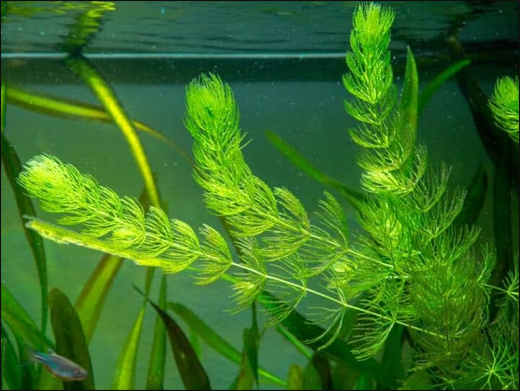Ceratophyllum demersum Linn./ Sivara/ Coontail – Ayurvedic Properties, Practical Uses & More
Abstract
Ceratophyllum demersum is a submerged, perennial aquatic macrophyte that typically grows with its stem base anchored in sandy or silty substrates. It is commonly found in stagnant or slow-moving freshwater bodies. This delicate, free-floating, rootless underwater plant is densely leafy, with foliage clustering at the tips to resemble a bushy animal tail. It reproduces both vegetatively and through seeds. Beyond its ecological role, it is recognised for its medicinal value in traditional healing systems. The plant acts as a bioindicator of water quality and possesses therapeutic potential due to its distinct phytochemical constituents. Growing interest in natural medicine has renewed focus on its use in herbal remedies and environmental conservation.

Introduction
Ceratophyllum demersum, commonly known as Coontail or Hornwort, is a cosmopolitan, perennial aquatic plant. Its name is derived from the Greek words keras (horn) and phyllon (leaf), reflecting the horn-like appearance of its whorled leaves. It is popular in the aquarium and pond plant trade due to its ornamental foliage and ease of growth. This submerged macrophyte typically grows with its stem base embedded in silty or muddy substrates. Traditionally, various parts of the plant have been used to manage conditions such as fever, wounds, skin ailments and infections. Ongoing scientific research highlights its rich phytochemical profile and therapeutic potential. Its ecological versatility, along with a wide spectrum of pharmacological properties, underlines its significance in both environmental and traditional medicinal applications.
Scientific Classification
- Kingdom: Plantae
- Clade: Tracheophytes
- Order: Ceratophyllales
- Family: Ceratophyllaceae
- Genus: Ceratophyllum
- Species: C. demersum
Synonyms
- Jalaja – Found in water
- Jalakesha – Resembles hair spread in water
- Jalaneela
- Jalamundapi
- Toya Kumbhi – Grows in water
- Toya Vruksha – Aquatic tree
- Paneeya Prushta – Found on water surfaces
- Vari Parni – Leafy aquatic plant
- Hatha
- Kuli
- Kumbhi
- Dhandhana
- Vrukadhumaka
- Shaivala
Vernacular Names
- English Name – Coon tail, Hornwort, Rigid hornwort, Coontail, Coon’s tail
- Hindi Name – Sevar, Kaayi, Sivar
- Gujarati Name – Saivala
- Marathi Name – Saivala
- Tamil Name – Velampasi
- Telugu Name – Nachu
- Bengali– Pani ghas
- Kannada– Neer soppu
- Assamese– Pani bon
- Malayalam– Neer cheera
- Oriya– Pani sag
Habitat
Ceratophyllum demersum commonly thrives in sheltered aquatic environments such as standing or slow-moving clear water bodies. It is frequently found in ponds, dams, streams and reservoirs, especially in areas with silty or muddy bottoms. This plant prefers calm conditions and is well adapted to submerged freshwater habitats.
Morphology
Ceratophyllum demersum is a submerged aquatic plant, though it may occasionally float on the water surface. Its stems can grow between 1 to 3 meters long, bearing whorls of bright green, narrow, and often highly branched leaves at each node. These forked leaves vary in texture—brittle and stiff in some species, soft in others. The plant lacks true roots but may develop modified, root-like leaves that help anchor it to the substrate. Flowers are small, inconspicuous and monoecious (both male and female flowers on the same plant). In colder seasons, it produces dense overwintering buds (turions) that sink and regrow in spring. This herb is commonly found in water bodies of hilly regions across North and Eastern India.
Varieties
Some researchers considered Vellisneria spiralis Linn. as Shaivala. It is found all over India. Its shrubs are submerged in water, stemless and are clustered together. Leaves are linear, very long and translucent. Flowers- Male flowers are in a small leafy cluster and are very small and many in number. On maturing, they separate from the cluster and come above the water and bloom. Female flowers are attached to long, coiled stems and on maturing, the coil opens, and they come up, and on fertilisation, they again coil around the stem and go down.
Qualities and Uses
It is a lightning and astringent. It is used in leucorrhoea. Tying it on a boil reduces the burning sensation, and it bursts quickly.
Classical Categorisation
- According to Bhavaprakasha – Pushpavarga (Group of Flowers)
- According to Kaiyyadeva Nighantu – Aushadhi Varga (Group of Medicinal Herbs)
- According to Raja Nighantu – Shalmalyadi Varga (Group starting with Shalmali)
Ancient Verses
शैवालं तुवरं तिक्तं मधुरं शीतलं लघु । स्निग्धं दाहतृषापित्तरक्तज्वरहरं परम् ॥
(Bhavprakash Nighantu Pushpa varga 21)
According to the above shloka, Shaivala has bitter and sweet taste, cold potency and light and unctuous properties. It is effective in the management of burning sensation, excess thirst, excess Pitta dosha, bleeding disorders and fever.
Ayurvedic Properties
- Taste (Rasa) – Bitter (Tikta), Sweet (Madhur)
- Physical property (Guna) – Light (Laghu), Unctuous (Snigdha)
- Potency (Veerya) – Cold Potency (Sheet)
- Post-digestion effect (Vipaka) – Katu (Pungent)
- Effect on tridosha – Balance all three doshas
Therapeutic Properties
- Pittasra – Raktapitta – Bleeding disorders such as nasal bleeding, heavy periods, etc
- Jwara – Fever-related conditions, including viral or seasonal fevers
- Shosha – Emaciation, dehydration, and general tissue depletion
- Santapa – Burning sensation caused by heat, toxins, or inflammation
- Vrana – Ulcers, wounds, and chronic non-healing skin lesions
- Daha – Burning sensation, as in gastritis, neuropathy, eye burning, etc
- Trushna – Excessive thirst, often due to heat or fluid imbalance
Systemic Actions
External Application
Useful in reducing bleeding and relieving burning sensations. Applying its paste externally is recommended for bleeding haemorrhoids.
Internal Use
- Nervous System – Enhances intellect and calms the mind and is beneficial in epilepsy, dizziness and related conditions.
- Digestive System – It acts as an absorber and is useful for treating excessive thirst and blood in diarrhoea.
- Circulatory System– It is helpful in managing bleeding disorders.
- Tapakrama – It is effective in fevers accompanied by burning sensations.
Chemical Composition
- Toluene – 6.8%
- Hexanal – 5.4%
- 1-Hexanol – 1.9%
- Heptanal – 1.7%
- Nonanal – 1%
- 2,6-Dimethylcyclohexanol – 2.9%
- 3-Ethyl-4-methyl-1H-pyrrole-2,5-dione – 2.2%
- 2-Methylpropanoic acid 2,2-dimethyl-1-(2-hydroxy-1-methylethyl) propyl ester – 7.6%
- 2-Methylpropanoic acid 3-hydroxy-2,4,4-trimethylpentyl ester – 15%
- β-Ionone-5,6-epoxide – 7.6%
- Dihydroactinidiolide – 3.7%
- β-Asarone – 3%
- Pentadecanal – 3.3%
- 6,10,14-Trimethyl-2-pentadecanone – 2.8%
- 1,2-Benzenedicarboxylic acid di(2-methylpropyl) ester – 5%
- 1,2-Benzenedicarboxylic acid dibutyl ester – 1%
- Alkaloids
- Cardiac glycosides
- Glycosides
- Tannins
- Flavonoids
Modern Overview
Analgesic Activities
The methanolic extract of Ceratophyllum demersum at doses of 250 mg/kg and 500 mg/kg body weight (p.o.) was evaluated for its analgesic potential using the acetic acid-induced writhing test in albino mice. The treatment resulted in a notable reduction in the number of writhes, demonstrating dose-dependent pain-relieving activity of the extract.
Antiulcer Activities
The antiulcer potential of methanolic and aqueous extracts of Ceratophyllum demersum was evaluated in rats at doses of 250 mg/kg and 500 mg/kg body weight. Phytochemical analysis confirmed the presence of glycosides, flavonoids, alkaloids, steroids, and tannins in the whole plant. Both extracts, particularly at 500 mg/kg, demonstrated a notable increase in gastric pH and mucus production, alongside a reduction in gastric acid volume, free acidity, total acidity and ulcer index. These findings support the traditional use of Ceratophyllum demersum in managing ulcerative conditions.
Antidiarrheal Activities
The antiulcer potential of methanolic and aqueous extracts of Ceratophyllum demersum was evaluated in rats at doses of 250 mg/kg and 500 mg/kg body weight. Phytochemical analysis confirmed the presence of glycosides, flavonoids, alkaloids, steroids, and tannins in the whole plant. Both extracts, particularly at 500 mg/kg, demonstrated a notable increase in gastric pH and mucus production, alongside a reduction in gastric acid volume, free acidity, total acidity and ulcer index. These findings support the traditional use of Ceratophyllum demersum in managing ulcerative conditions.
Practical Uses
- A paste prepared from Shaivala (Ceratophyllum demersum) is applied externally on piles to alleviate pain and reduce the burning sensation around the anal region.
- Fresh juice of Ceratophyllum demersum (10–20 ml) is administered to help relieve fever, intense thirst, burning sensation during urination, and overall body heat.
- A cold infusion (50–60 ml) made from the herb is used to manage cases of bloody diarrhoea and provides soothing relief.
- For fresh wounds accompanied by swelling and pain, a paste of Shaivala is topically applied to support healing and reduce inflammation.
- Medicated ghee prepared with Ceratophyllum demersum (Shaivala), Nelumbo nucifera (Kamala Nala – lotus stem) and Terminalia arjuna (Arjuna) is traditionally used to enhance cardiac muscle strength and support heart health.
- In skin conditions like herpes, a cooling paste made from Ceratophyllum demersum (Shaivala), Santalum album (Chandana – sandalwood) and Cynodon dactylon (Durva) is applied to the affected area to reduce symptoms.
- For scorpion sting and associated pain, a paste combining Ceratophyllum demersum (Shaivala), butter, and leaf pastes of Albizia lebbeck (Shirisha) and Curcuma longa (Haridra) is traditionally used as an antidote and pain reliever.
Part Used
Whole plant
Dosage
Fresh juice- 10-20 ml
Conclusion
Ceratophyllum demersum Linn., a valuable aquatic plant, offers a wide range of therapeutic applications alongside its environmental benefits. Its bioactive constituents exhibit promising pharmacological effects, particularly in traditional wound healing, fever management, and detoxification. With growing interest in plant-based medicine and sustainable ecological practices, Ceratophyllum demersum stands out as a multipurpose herb worthy of deeper scientific exploration and wider traditional use.



